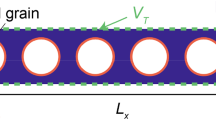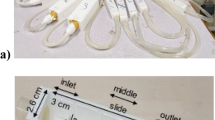Abstract
We adapt a set of differential equations commonly used in the mathematical biofilm literature to study the interaction between biofilm growth and fluid flow in seafloor hydrothermal systems. The resulting equations admit a steady state solution; phase space analysis indicates that the system will converge to this point from a wide variety of initial conditions. We present numerical solutions of the biofilm equations in which detachment processes dominate at the base of the system and a biofilm-rich zone propagates upward, halting before reaching the surface. The maximum height of this zone depends on the vigor of fluid flow and the concentration of limiting nutrient. We find no solutions resulting in cyclically varying rock permeability. There is, however, a characteristic time scale for the zone of high biofilm concentration or lowered permeability to reach minimum subsurface depth.





Similar content being viewed by others
References
Colwell, F.S., Smith, R.P.: Unifying principles of the deep terrestrial and deep marine biospheres. Wash. DC Am. Geophys. Union Geophys. Monogr. Series 144, 355–367 (2004). https://doi.org/10.1029/144GM22
Embley, R.W., Lupton, J.E.: Diking, event plumes, and the subsurface biosphere at mid-ocean ridges. Wash. DC Am. Geophys. Union Geophys. Monogr. Series 144, 75–97 (2004). https://doi.org/10.1029/144GM06
Gulmann, L.K., Beaulieu, S.E., Shank, T.M., Ding, K., Seyfried, W.E., Sievert, S.M.: Bacterial diversity and successional patterns during biofilm formation on freshly exposed basalt surfaces at diffuse-flow deep-sea vents. Front. Microbiol. 6, 901 (2015). https://doi.org/10.3389/fmicb.2015.00901
Haymon, R.M., Fornari, D.J., Von Damm, K.L., Lilley, M.D., Perfit, M.R., Edmond, J.M., Shanks, W.C., Lutz, R.A., Grebmeier, J.M., Carbotte, S., Wright, D., McLaughlin, E., Smith, M., Beedle, N., Olson, E.: Volcanic eruption of the mid-ocean ridge along the East Pacific Rise crest at 9\(^{\circ }\)45-52’N: Direct submersible observations of seafloor phenomena associated with an eruption event in April, 1991. Earth Planet. Sci. Lett. 119(1), 85–101 (1993). https://doi.org/10.1016/0012-821X(93)90008-W
Kapellos, G.E., Alexiou, T.S., Pavlou, S.: Chapter 8 - Fluid-Biofilm Interactions in Porous Media. In: Becker, S.M., Kuznetsov, A.V. (eds.) Heat Transfer and Fluid Flow in Biological Processes, pp. 207–238. Academic Press, Boston (2015). https://doi.org/10.1016/B978-0-12-408077-5.00008-0
Lewis, K.C., Lowell, R.P.: Numerical modeling of two-phase flow in the NaCl-H \(_{\rm 2 }\) O system: 2. Examples. J. Geophys. Res. 114(B8), B08204 (2009). https://doi.org/10.1029/2008JB006030
Lewis, K.C., Lowell, R.P.: Numerical modeling of two-phase flow in the NaCl-H \(_{\rm 2}\) O system: introduction of a numerical method and benchmarking. J. Geophys. Res. 114(B5), B05202 (2009). https://doi.org/10.1029/2008JB006029
Lewis, K.C., Coakley, S., Miele, S.: An extension of the stefan-type solution method applicable to multi-component, multi-phase 1D systems. Transp. Porous Med. 117(3), 415–441 (2017). https://doi.org/10.1007/s11242-017-0840-1
Lewis, K.C., Nardea, M., Halpern, M.J.: An analytical model for flow of seawater adjacent to an igneous wall. Transp. Porous Med. 126(2), 475–499 (2019). https://doi.org/10.1007/s11242-018-1172-5
Lowell, R.P., Crowell, B.W., Lewis, K.C. and Liu, L.: Modeling Multiphase, Multicomponent Processes at Oceanic Spreading Centers. In: Magma to Microbe, pages 15–44. American Geophysical Union (AGU), (2008). ISBN 9781118666357. 10.1029/178GM03
Ramírez, G.A., Garber, A.I., Lecoeuvre, A., D’Angelo, T., Wheat, C.G., Orcutt, B.N.: Ecology of subseafloor crustal biofilms. Front. Microbiol. (2019). https://doi.org/10.3389/fmicb.2019.01983
Schrenk M.O., Holden J.F., Baross J.A.: Magma-To-Microbe Networks in the Context of Sulfide Hosted Microbial Ecosystems. In: Magma to Microbe, pages 233–258. American Geophysical Union (AGU), 2008. ISBN 9781118666357. https://doi.org/10.1029/178GM12
Shock, Everett, Holland, Melanie E.: Geochemical energy sources that support the subsurface biosphere. Subseafloor Biosph. Mid-Ocean Ridges 2004, 153–165 (2004). https://doi.org/10.1029/144GM10. (https://asu.pure.elsevier.com/en/publications/geochemical-energy-sources-that-support-the-subsurface-biosphere)
Turcotte, D.L. and Schubert, G.: Geodynamics. Cambridge University Press, (2002). ISBN 9780521666244
Wanner, O., Reichert, P.: Mathematical modeling of mixed-culture biofilms. Biotechnol. Bioeng. 49(2), 172–184 (1996)
Wanner, O.: Mathematical modeling of biofilms. IWA Pub., (2006). ISBN 9781843390879. URL https://agris.fao.org/agris-search/search.do?recordID=US201300120281
Acknowledgements
This paper is dedicated to the memory of the friend and former Ph.D. advisor of K.C. Lewis, Robert P. Lowell, who originally inspired the idea for this work.
Funding
The authors have not disclosed any funding.
Author information
Authors and Affiliations
Corresponding author
Ethics declarations
Conflict of interest
This work was not funded by any grant. The authors have no relevant financial interests to disclose.
Additional information
Publisher's Note
Springer Nature remains neutral with regard to jurisdictional claims in published maps and institutional affiliations.
7 Appendix
7 Appendix
1.1 7.1 Leibniz formula
Assume that we have a function of the form f(x, y, t) and let \(\zeta\) equal y or t. If we integrate the derivative of this function with respect to \(\zeta\) from \(x=0\) to \(x=g(y,t)\), we obtain
1.2 7.2 Alternative derivation of (70)
As before we begin with \(\int _0^w\phi Cdx=\phi _b L {\bar{C}}+\int _L^w Cdx\). But now, with the idea that the integral is the area under the curve in mind (see Fig. 6), we approximate the integral on the right hand side with \((w-L){\bar{C}}\). In this way, we obtain
Hence,
as before.
Rights and permissions
About this article
Cite this article
Lewis, K.C., Alicea, M. & Jafri, M. Interaction Between Biofilm Growth and Fluid Flow in Seafloor Hydrothermal Systems. Transp Porous Med 143, 765–786 (2022). https://doi.org/10.1007/s11242-022-01812-5
Received:
Accepted:
Published:
Issue Date:
DOI: https://doi.org/10.1007/s11242-022-01812-5





